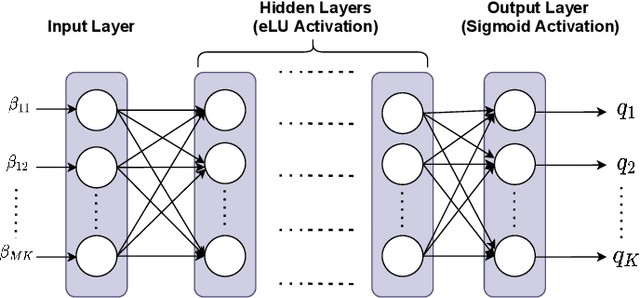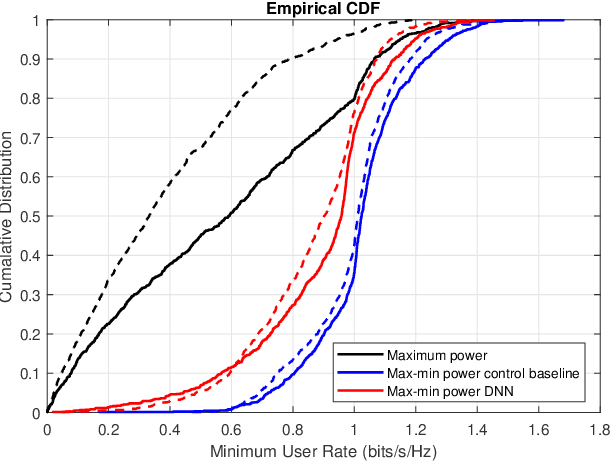Nuwanthika Rajapaksha
Minimizing Energy Consumption in MU-MIMO via Antenna Muting by Neural Networks with Asymmetric Loss
Jun 08, 2023Abstract:Transmit antenna muting (TAM) in multiple-user multiple-input multiple-output (MU-MIMO) networks allows reducing the power consumption of the base station (BS) by properly utilizing only a subset of antennas in the BS. In this paper, we consider the downlink transmission of an MU-MIMO network where TAM is formulated to minimize the number of active antennas in the BS while guaranteeing the per-user throughput requirements. To address the computational complexity of the combinatorial optimization problem, we propose an algorithm called neural antenna muting (NAM) with an asymmetric custom loss function. NAM is a classification neural network trained in a supervised manner. The classification error in this scheme leads to either sub-optimal energy consumption or lower quality of service (QoS) for the communication link. We control the classification error probability distribution by designing an asymmetric loss function such that the erroneous classification outputs are more likely to result in fulfilling the QoS requirements. Furthermore, we present three heuristic algorithms and compare them with the NAM. Using a 3GPP compliant system-level simulator, we show that NAM achieves $\sim73\%$ energy saving compared to the full antenna configuration in the BS with $\sim95\%$ reliability in achieving the user throughput requirements while being around $1000\times$ and $24\times$ less computationally intensive than the greedy heuristic algorithm and the fixed column antenna muting algorithm, respectively.
Deep Learning-based Power Control for Cell-Free Massive MIMO Networks
Feb 20, 2021



Abstract:A deep learning (DL)-based power control algorithm that solves the max-min user fairness problem in a cell-free massive multiple-input multiple-output (MIMO) system is proposed. Max-min rate optimization problem in a cell-free massive MIMO uplink setup is formulated, where user power allocations are optimized in order to maximize the minimum user rate. Instead of modeling the problem using mathematical optimization theory, and solving it with iterative algorithms, our proposed solution approach is using DL. Specifically, we model a deep neural network (DNN) and train it in an unsupervised manner to learn the optimum user power allocations which maximize the minimum user rate. This novel unsupervised learning-based approach does not require optimal power allocations to be known during model training as in previously used supervised learning techniques, hence it has a simpler and flexible model training stage. Numerical results show that the proposed DNN achieves a performance-complexity trade-off with around 400 times faster implementation and comparable performance to the optimization-based algorithm. An online learning stage is also introduced, which results in near-optimal performance with 4-6 times faster processing.
Low Complexity Autoencoder based End-to-End Learning of Coded Communications Systems
Nov 19, 2019



Abstract:End-to-end learning of a communications system using the deep learning-based autoencoder concept has drawn interest in recent research due to its simplicity, flexibility and its potential of adapting to complex channel models and practical system imperfections. In this paper, we have compared the bit error rate (BER) performance of autoencoder based systems and conventional channel coded systems with convolutional coding, in order to understand the potential of deep learning-based systems as alternatives to conventional systems. From the simulations, autoencoder implementation was observed to have a better BER in 0-5 dB $E_{b}/N_{0}$ range than its equivalent half-rate convolutional coded BPSK with hard decision decoding, and to have only less than 1 dB gap at a BER of $10^{-5}$. Furthermore, we have also proposed a novel low complexity autoencoder architecture to implement end-to-end learning of coded systems in which we have shown better BER performance than the baseline implementation. The newly proposed low complexity autoencoder was capable of achieving a better BER performance than half-rate 16-QAM with hard decision decoding over the full 0-10 dB $E_{b}/N_{0}$ range and a better BER performance than the soft decision decoding in 0-4 dB $E_{b}/N_{0}$ range.
 Add to Chrome
Add to Chrome Add to Firefox
Add to Firefox Add to Edge
Add to Edge